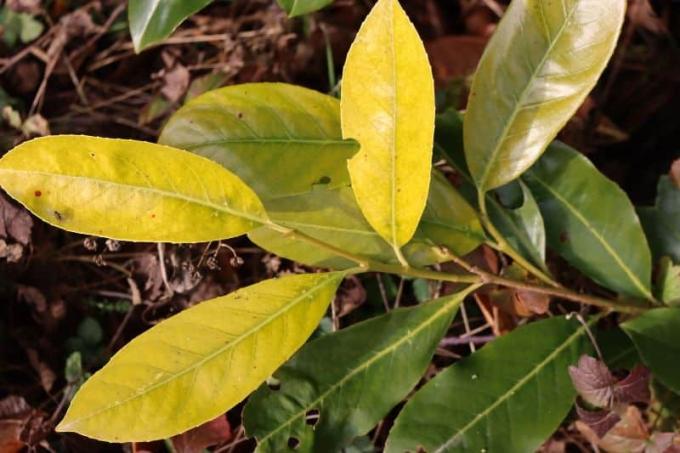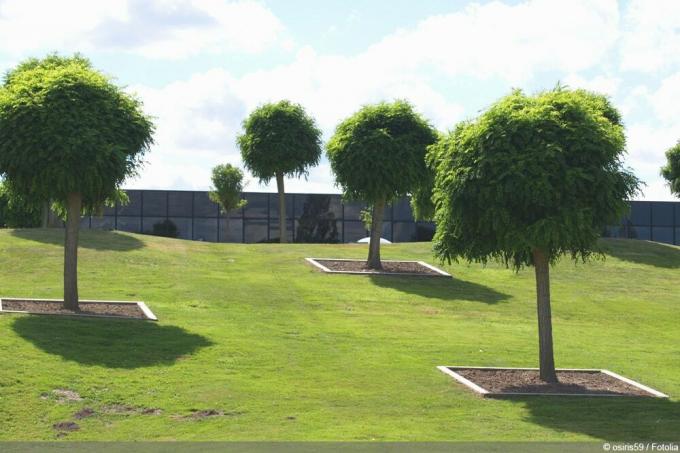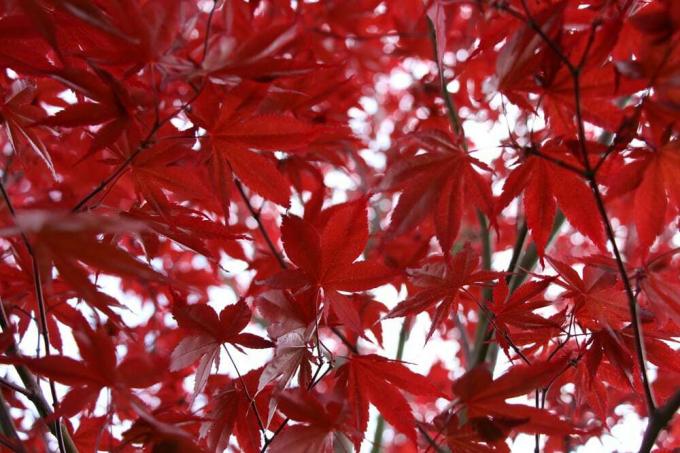

Table of contents
- Rododendron or rhododendron
- causes
- examination
- Rescue for potted plants
- Rescue for bedding plants
- pruning
If the rhododendron does not get the right care and is in the wrong location, it will quickly look dried up. In adverse conditions, the flowering shrub separates from all above-ground parts of the plant that are not necessary for its survival. If the plant has been cared for incorrectly, appropriate countermeasures must be taken promptly to prevent complete death.
Rododendron or rhododendron
A spelling mistake is often made with the plant, many people write rhododendron instead of rhododendron. The name is made up of the Greek "rhodon" for rose and "dendron" for tree, which is why this rose tree is always written with an "h".
causes
When rhododendrons appear dried up, this can have many different causes. Most often, the culprit is an inadequate supply of water. Especially in the hot summer months with little rainfall, leaves, flowers and shoots wither quickly. Many people also go on vacation during this time of the year, so the plants are not watered at all during this period. When watering, both the frequency and the amount of water used are crucial. These aspects must be individually adjusted to the size of the flowering shrubs, the site conditions and the weather.
- Long and extremely dry periods of heat weaken the plants
- Insufficient pouring units lead to dry patches
- Watering too little and at the wrong time
- Irrigation water evaporates quickly in the midday heat
- Lack of watering in the dry winter
- Damaged roots reduce water absorption
- Too many leaves were removed during pruning
- Sensitive plant suffers from diseases
examination

A close inspection will tell you whether the rhododendron is just drying up on the outside or is already completely dead. It is therefore important to pay attention to concrete facts in the plant, which indicate that there is still life. If cell structures remain intact, the flowering shrubs can form new plant tissue again. Only when the cells have lost more than seventy percent of water is the rhododendron in question as good as dead. Specimens that have dried out above ground can still live in the root area and can sprout again after the right measures. However, attempts to save a dried-up plant often remain unsuccessful. Nevertheless, it is always worth reviving, especially when it comes to older and larger plants,
- Scrape off some of the bark to check
- Green in the stem indicates life
- Trunk is still damp despite dried shoots
- Then rescue is possible
- Leaves are yellow but not brown in color
- Dropped leaves are often still green
- Flowers hang limp
- Leaves curl up together
Rescue for potted plants
As long as the roots of the potted plants are not damaged, attempts to rescue them are worthwhile and can certainly be crowned with success. Since one of the most common causes of dried-up plant parts is a lack of watering units, the plants must first be supplied with plenty of liquid. With potted plants, however, there is a risk of harmful overwatering. It is therefore advisable to give the plants an extensive water bath. Once the substrate has almost dried out, it will no longer be able to absorb and store water so well in the future. Therefore, repotting is a good idea, as this also ensures good ventilation. Also, the weakened plant needs the right fertilizers to get vital nutrients. In this way, the rhododendron can soon regain its energy.
- Place the plant and bucket in a bucket of water
- However, the vessel must have a drainage hole
- Otherwise put the plant in the water bath without a pot
- Roots and substrate must absorb sufficient water
- Only remove when no more air bubbles rise
- However, do not leave in the water bath for more than a day
- Repot and provide fresh substrate
- Carry out intensive fertilizer treatment
- Fertilizers specifically for rhododendrons are ideal
- Never spread fertilizer on dry soil
A notice:
Never place rhododendrons in direct sunlight. Provide sun protection in the midday heat on a window sill in full sun.
Rescue for bedding plants

In the case of potted plants, the rescue measures are much easier because they can be moved and repotted individually. In contrast, this is not possible with rhododendrons in the bed. Small plants can still be carefully dug up and then placed in a water bath. In contrast, larger specimens are firmly rooted in the location and do not survive a move without serious damage. Nevertheless, a dried-up rhododendron in the bed can still be saved with the appropriate measures if the roots are still alive. It is important to protect against too much strong sun and evaporation in order to keep the moisture in the soil longer. In addition, the prevailing conditions at the site can also be changed in order to protect the plants from drought.
- First loosen the soil around the shrubs
- Then water extensively, directly on the rootstock
- About 10-20 liters per day, depending on plant size and weather conditions
- Carry out pouring sessions over several days
- A watering can with a liter indication is ideal
- Install sun protection in full sun
- Other plants that provide shade are ideal
- Lay a thick layer of mulch over the root area
- Only fertilize again when the crop has noticeably recovered
Tip:
An automatic watering system is a good way to regularly supply the rhododendrons in the bed with sufficient water. In this way, a longer holiday stay does not become a problem.
pruning
If the leaves of the flowering shrubs are almost completely brown, new shoots are extremely unlikely. Curled and dried leaves provide a natural protection against excessive evaporation. In this case, the plants should be pruned back as soon as possible to avoid further drying out. In this way, the already very weak plant does not exhaust itself with the care of the dried shoots. The rhododendron then puts its remaining energy into the formation of new shoots. Pruning is necessary for both potted plants and bedding plants, and not just for aesthetic reasons. This allows the plant to regenerate and will soon sprout again if further care meets the respective requirements. Depending on how much the rhododendron has already dried up, the new sprouting can take place promptly or take longer.
- Cutting encourages new shoots
- Apply radical pruning to revive
- Cut off all dead plant parts
- Make the cut close to the trunk
- If possible, leave the main shoots
- If necessary, even cut back to the stick
- Pay attention to sharp and disinfected scissors
- It is essential to avoid unnecessary injuries
 garden editorial
garden editorial I write about everything that interests me in my garden.
Learn more about shrubs

Cherry laurel has yellow / brown leaves: what to do?
Cherry laurel is one of the hardy garden plants in the garden. Nevertheless, it can happen that the leaves of the cherry laurel turn yellow or brown. The causes are manifold. Since some can kill the cherry laurel, you should investigate.

12 native evergreen shrubs & woody plants
Dreary, bare trees and bushes in winter? It doesn't have to be. Even in the European climatic conditions, native, evergreen trees thrive splendidly. The variety of species even enables the gardener to adapt his privacy hedge exactly to his garden design. This guide presents the most beautiful native and evergreen shrubs and woody plants.

Curb Vinegar | Does bucket or root barrier help?
Vinegar trees like to spread in the garden and sometimes even drive other plants away. However, this can be avoided by curbing the growth of the trees. You can find out which methods are best suited for this here!

Winter jasmine, Jasminum nudiflorum | Care, propagation & pruning
The winter jasmine is a relatively frugal and robust plant that can cope with many different site conditions. The plant enchants with bright yellow flowers in winter and tolerates deep sub-zero temperatures very well. It should be pruned regularly and is easy to propagate.

Ball Tree: Care from A – Z | These 9 varieties are suitable for ball trees
Ball trees adorn many a garden, front yard and entrance area. They require little space. Their trunk thickens with age, but its height remains the same. The spherical crown is easy to trim. Nevertheless, they offer everything that makes a tree.

Red Norway Maple: Basic Care | Red-leaved maple
Red maple is well on the way to overtaking its green-leaved counterpart as a popular house tree. This guide will acquaint you with the basics of care so that the red-leaved premium variety can make the most of a representative welcoming committee in the garden.



